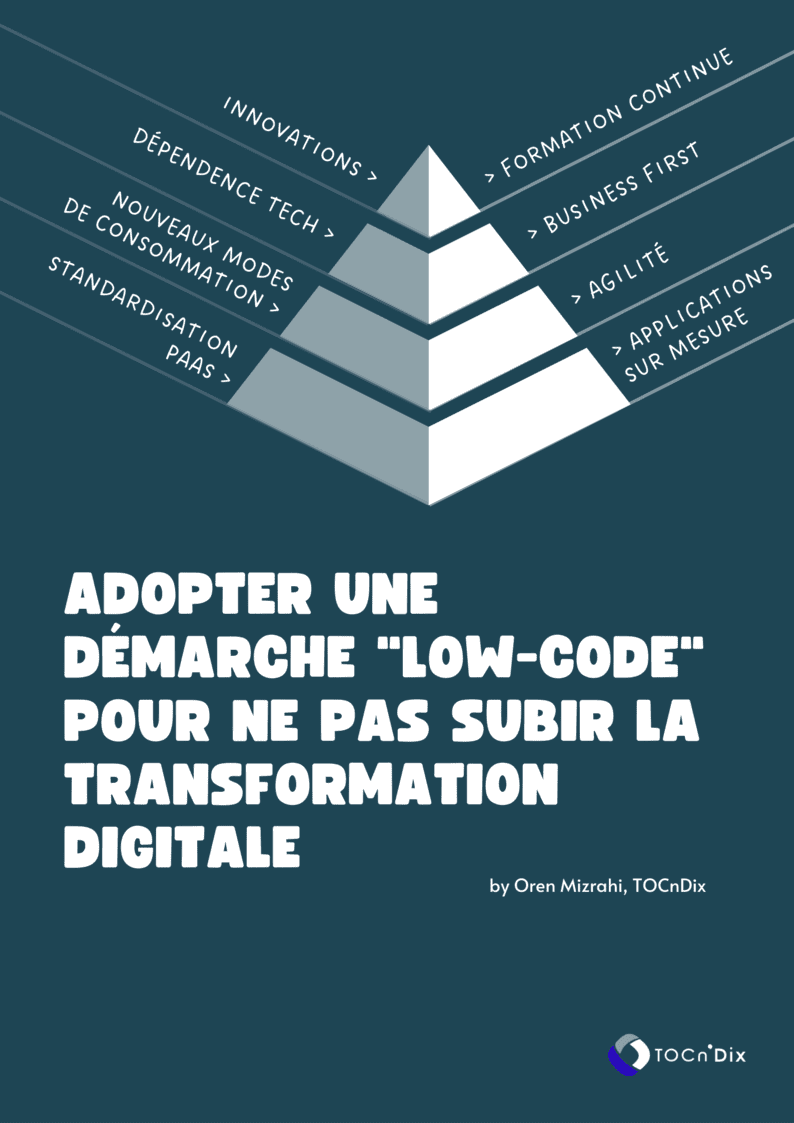LOW CODE & TECHNOLOGY
Low Code, this technology that lives up to its name very badly
September 26, 2023

Adopting a so-called “low-code” platform makes it possible to develop applications without having to write traditional lines of code. Naturally, this time saving allows low-code to keep its promises: gains in agility, reduction in “Time To Market” and lower development costs.
The application development revolution
Low-code tools reflect the possibility of achieving your goals by writing only a little code (unlike no-code which does not involve the intervention of programmers and the writing of code at all).
However, behind this name lies an approach, a state of mind and the required skills, going well beyond the relationship with the code. The title « low » usually used to describe these tools is misleading. It can indeed be perceived as reductive and pejorative and we can legitimately wonder if low-code is not misnamed and if it does not deserve a complete rebranding to earn the title of nobility that is due to it.
The low coder: degraded developer or augmented designer-programmer?
All platforms providing application design solutions using more or less intuitive interfaces still require learning their own pseudo-code. The language is supposed to be simpler, intuitive, often visual and therefore more accessible, but the fact remains that it is above all a language that must be understood and mastered.
Furthermore, a good « low-codeur » must also equip themselves with developer skills and reflexes: conceptualization, transcription of expressed and unexpressed needs into code, optimization of resource management, analytical skills, listening and dialogue with clients, are skills as much required of a low-coder as of a traditional developer, if not more.
When should you repeat an existing module? When should it be adapted? Which widget is secure enough to download from the marketplace? What function should be made modular and available to the community? Which module is legitimately monetizable? How to guarantee maintainability, security and efficiency? So many questions that contradict the idea that it is simpler to do low-code.
Going against the grain, we will expect a low code developer to be an end-to-end application designer more quickly. The choice of low-code indicates a strong expectation of developers who are more understanding and close to the functional needs. They are generally expected to take a closer approach to technology consulting with an ability to look beyond detailed functional specifications. A low-coder must have a culture of the entire value chain offered by low-code platforms and knowledge of the ecosystem, with the specificities, strengths and weaknesses of each actor.

« Low-code is for multi-talented coders.»
Low code requires developers to strongly question their knowledge and continually learn complementary skills. Gaining seniority for a low-code developer necessarily involves seeking great versatility. At a time when AI will replace developers, it will be good to be on the side of the thinkers and designers of applications – less subject to competition from algorithms – than on the side of the experts in future dead code languages.
While the watchword is “speed”, we must be able not only to develop but also to systematically evaluate the alternatives in order to decide and sometimes choose not to do so. Sometimes taking the responsibility of relying on a solution developed by others among the countless options available requires much more than knowing how to code. It’s about knowing how to design your application by knowing how to “source” from the different options. Also, low-coders must quickly gain technological maturity and demonstrate real business sensitivity in order to progress.
“The ability to code quickly represents only the visible side of the iceberg democratized by the multitude of no-code tools on the market. »
In mirror image, multipotentialist, hyper-sensitive, hyper-empathetic code laypeople and other HPIs in business will find their developer acolytes on low-code platforms, which open the doors to the design and development of real applications for technophile talents. « Citizen Developement is for highly skilled non-developers ». Thus, low-code platforms in companies will become the playgrounds of intrapreneurs, hackathon organizers, innovation officers, UX and other priests of digitalization.
From low code to tailor-made application platforms
Having nothing « low » , low code platforms are not limited to the function of coding. This reductive name risks repelling the best developers and makes it more difficult to understand the potential hidden in these very comprehensive tools.
Choosing an application design and management platform actually means arming yourself with a range of essential management tools in the era of the digital race.
Choosing an application management platform means starting a process of optimizing your application portfolio. It means systematizing the search for efficiency by automating tasks with low added value or processes requiring a frequency that human resources cannot match.
Adopting a low-code platform means giving yourself an additional reason to audit your IT systems and map your applications, databases and other DATA sources in order to make them available via documented and governed libraries and hubs. Encouraging low-code means recognizing that we want to guarantee the reliability of data and “single sources of truth”.
By adopting “low-code first” governance and developing internal or external centers of excellence (COE) as well as teams responsible for innovation and IT governance, CIOs activate internal digital transformation. These application hubs allow the replacement of the legacy of successive non-coherent and non-connected application layers (legacy) and offer a serious alternative to spreadsheets shared on the cloud. By activating this ability to simply develop intuitive interfaces that are easy to connect to ERP, CRM, DMP and other software packages, IT departments make it possible to secure access to critical information, encourage the circulation of data and avoid enormous expenses with each customization and version upgrade. « Let your ERP in the Vanilla »
Choosing an application platform based on low code means giving yourself the means to implement a shadow-IT reduction policy by strengthening the IT department’s capacity to do so, by reducing the backlog of development requests and by creating management the innovation of real internal consulting agencies equipped with armed arms to develop both internal startups and verified business model ideas.
From low code to business digitalization platforms
The ability to code quickly is only the visible side of the iceberg democratized by the multitude of no-code tools on the market. However, in a large company, adopting a low-code approach means above all equipping yourself with an arsenal of technologies allowing you to evolve quickly and calmly.
Choosing a Low-Code Application platform (LCAP) editor means continually updating your IS service catalog by connecting it to the latest widget libraries, APIs and other microservices. It means banking on the strength of the collective to allow your organization to specialize in its field or dream of secure, tailor-made applications for internal and external use.
Adopting an approach based on low code means arming yourself with the ability to decide quickly and the power to appropriate digital innovations rather than undergoing the forced digitalization of the company. Digitalization platforms make it possible to more quickly deploy new products, new service offerings and a better experience for the nomadic and demanding digital consumers that we have become.

Generally based on 100% cloud foundations and associated with the promise of scalability of “on demand” capacities, these platforms allow real economies of scale, to “scale” a company by allowing flexibility of technological means and human resources unthinkable even ten years ago.
Digital transformations are thus better controlled, IT departments are strengthening their position as agile service centers guaranteeing reliability, security, maintainability and becoming hubs for integrating new technologies.

From low code to business digitalization platforms
The ability to code quickly is only the visible side of the iceberg democratized by the multitude of no-code tools on the market. However, in a large company, adopting a low-code approach means above all equipping yourself with an arsenal of technologies allowing you to evolve quickly and calmly.
Choosing a Low-Code Application platform (LCAP) editor means continually updating your IS service catalog by connecting it to the latest widget libraries, APIs and other microservices. It means banking on the strength of the collective to allow your organization to specialize in its field or dream of secure, tailor-made applications for internal and external use.
Adopting an approach based on low code means arming yourself with the ability to decide quickly and the power to appropriate digital innovations rather than undergoing the forced digitalization of the company. Digitalization platforms make it possible to more quickly deploy new products, new service offerings and a better experience for the nomadic and demanding digital consumers that we have become.
The winning trio of digital acceleration: Data, Artificial Intelligence and Low-Code
With COVID-19, the role of the CIO has become central within the company. To anticipate the post-COVID era, he must prepare to take on many challenges
7 reasons to adopt low-code to accelerate digital transformation
Our expertise in digitalization within the insurance sector enables us to have a sharp insight into the use of Low Code in this field of business today. Here are the reasons that make low-code an indispensable tool for leaders in the insurance industry.
Insurance, the preferred sector of Low-Code 2023
Our expertise in digitalization within the insurance sector enables us to have a sharp insight into the use of Low Code in this field of business today. Here are the reasons that make low-code an indispensable tool for leaders in the insurance industry.


